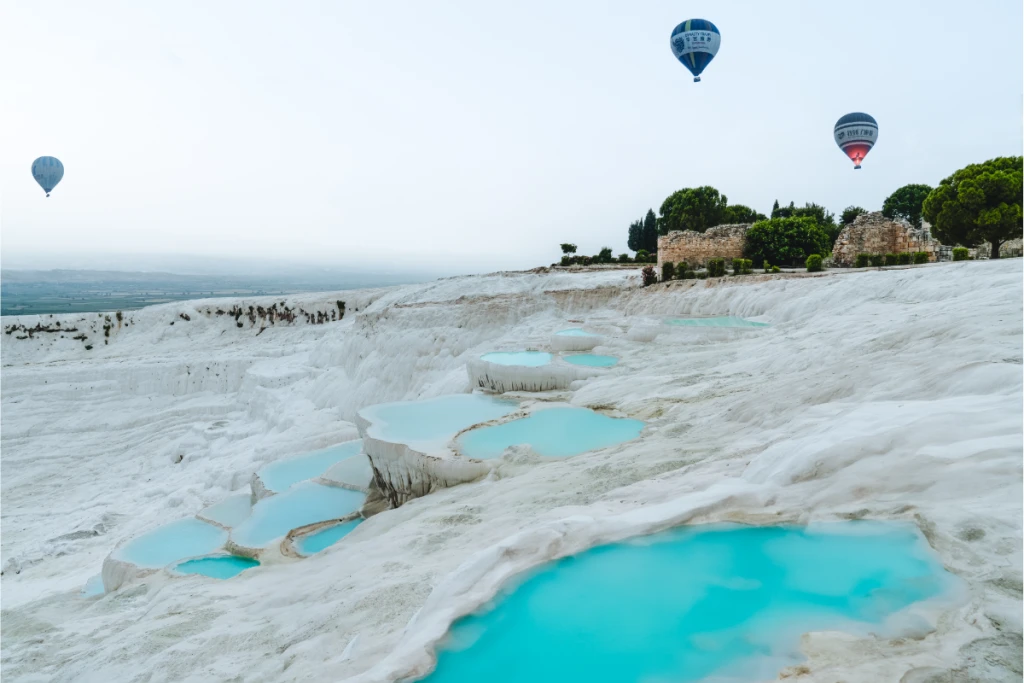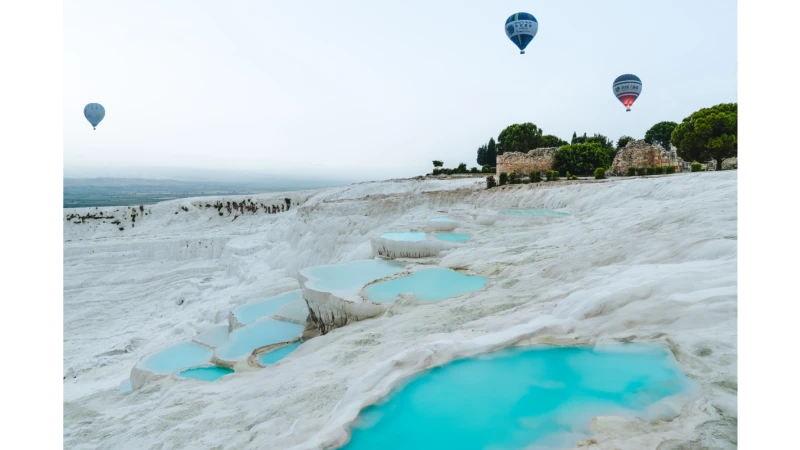Pamukkale Travel Guide – Cotton Castle & Ancient Hierapolis

🏞️ Pamukkale Travel Guide – Cotton Castle & Ancient Hierapolis
Pamukkale, literally meaning “Cotton Castle” in Turkish, is one of Turkey’s most unique and breathtaking natural wonders. Famous for its white travertine terraces filled with thermal waters and the ancient city of Hierapolis, Pamukkale combines natural beauty, history, and wellness.
Designated as a UNESCO World Heritage Site, Pamukkale attracts millions of visitors every year who come to walk on the gleaming white terraces, bathe in thermal pools, and explore the fascinating ruins of Hierapolis.
This travel guide will cover everything you need to know about Pamukkale: its history, top attractions, thermal baths, travel tips, and why it should be on your Turkey itinerary.
🌍 What Makes Pamukkale Special?
Pamukkale’s terraces were formed over thousands of years as calcium-rich hot spring water cascaded down the hillside, leaving behind dazzling white mineral deposits. The result is a surreal landscape of terraced pools that resemble cotton fields or frozen waterfalls.
The thermal waters have been used for healing since ancient times, attracting kings, travelers, and pilgrims who believed in their restorative powers.
📌 Top Attractions in Pamukkale
1. Cotton Castle (Travertine Terraces)
The main highlight of Pamukkale. Walking barefoot along the terraces, visitors can dip their feet in warm pools while enjoying spectacular views of the valley below.
2. Hierapolis Ancient City
Founded in the 2nd century BC, Hierapolis was a Greco-Roman spa city built around Pamukkale’s hot springs. Key highlights include:
- 🏛️ Theatre – A well-preserved Roman theatre with a capacity of 12,000 spectators.
- 🏺 Necropolis – One of the largest ancient cemeteries in Turkey.
- 🕍 Temple of Apollo – A central religious site of Hierapolis.
- 🏊 Baths & Basilicas – Remnants of thermal baths once used by Roman citizens.
3. Cleopatra’s Pool (Antique Pool)
A thermal pool filled with warm mineral water and submerged marble columns. Legend says Cleopatra herself swam here. Visitors can pay an extra fee to swim.
4. Pamukkale Natural Park
Located near the terraces, the park includes small lakes, cafes, and picnic areas.
5. Laodicea Ancient City (Nearby)
Just 15 km away, Laodicea offers extensive ruins including stadiums, theaters, and temples.
💦 Thermal Waters & Healing Power
Pamukkale’s thermal springs, ranging from 35–100°C, are rich in minerals believed to help with:
- Rheumatism
- Skin conditions
- Circulation problems
- Relaxation
Today, visitors still enjoy spa treatments and thermal hotels for wellness.
🚶 Things to Do in Pamukkale
- 👣 Walk barefoot on the travertines.
- 🏛️ Visit Hierapolis ancient ruins.
- 🏊 Swim in Cleopatra’s Pool.
- 📸 Capture sunrise or sunset photos.
- 🧘 Relax at a thermal spa resort.
🍴 Local Cuisine
Pamukkale is part of Denizli province. Some must-try dishes:
- Denizli Tandır Kebab – Slow-roasted lamb.
- Gözleme – Flatbread with fillings.
- Çökelek Salatası – Local curd cheese salad.
- Lokma & Baklava – Sweet desserts with tea.
🏨 Where to Stay
- Spa Hotels – Thermal resorts with pools.
- Boutique Hotels – Family-run, near travertines.
- Guesthouses – Affordable options for short stays.
🕒 Best Time to Visit
- Spring (Apr–Jun): Best weather.
- Autumn (Sep–Oct): Great for photos.
- Summer (Jul–Aug): Hot & crowded.
- Winter (Nov–Mar): Peaceful & quiet.
💡 Travel Tips
- Bring a swimsuit for Cleopatra’s Pool.
- Walk barefoot on travertines (shoes not allowed).
- Visit early morning or sunset to avoid crowds.
- Combine Pamukkale with Aphrodisias or Laodicea.
- Stay overnight to enjoy both day and night views.
🏆 Conclusion – Why Pamukkale Should Be on Your List
Pamukkale is one of Turkey’s most iconic destinations, offering a blend of natural beauty, ancient history, and thermal wellness. From the Cotton Castle terraces to Cleopatra’s Pool and Hierapolis ruins, it is a journey through both nature and history.
✨ Pamukkale – where the Cotton Castle meets the legacy of ancient Hierapolis.
🎫 Discover Pamukkale with Guided Tours
Visiting Pamukkale on your own is possible, but joining a guided Pamukkale tour makes the experience smoother and richer. Professional guides, hotel transfers, and skip-the-line access let you focus on enjoying the Cotton Castle without stress.
👉 Check out our Pamukkale Tours to explore the terraces, swim in Cleopatra’s Pool, and walk through Hierapolis with expert guidance.













